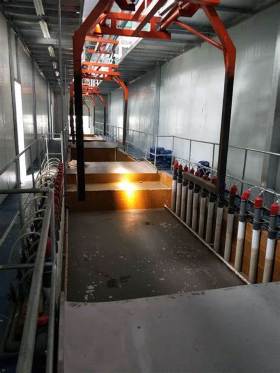Electrophoretic coating is a special coating technology, which is one of the most common methods for coating metal workpieces. Electrophoretic coating technology began in 1959 when Ford Motor Company of the United States conducted research on anodic electrophoretic primers for automotive applications, and built the first generation of electrophoretic coating equipment in 1963. Subsequently, the electrophoretic process developed rapidly.

The electrophoresis process is divided into anodic electrophoresis and cathodic electrophoresis. If the paint particles are negatively charged, the workpiece is the anode, and the paint particles are deposited on the workpiece to form a film under the action of the electric field force, which is called anodic electrophoresis; conversely, if the paint particles are positively charged, the workpiece is the cathode, and the paint particles are deposited on the workpiece to form a film, which is called anodic electrophoresis. Cathodic electrophoresis. The characteristics of anodic electrophoresis are: cheap raw materials (generally 50% cheaper than cathodic electrophoresis); simpler equipment and less investment (generally 30% cheaper than cathodic electrophoresis); lower technical requirements; and poorer corrosion resistance of the coating than cathodic electrophoresis ( Approximately one-quarter of the cathodic electrophoresis lifetime). The reasons for the high corrosion resistance of cathodic electrophoretic coatings are: the workpiece is a cathode, no anodic dissolution occurs, and the surface of the workpiece and the phosphating film are not damaged; electrophoretic coatings (generally nitrogen-containing resins) have a protective effect on metals, and the paint used is expensive excellent quality.
The process flow of electrophoretic spraying: hanging the workpiece (stainless steel, aluminum, copper) → ultrasonic wax and oil removal → water washing → pure water washing → pure water washing → red copper electrophoretic paint → pure water washing → pure water washing → pure water washing → drying → next hang.
The workpiece is hung (stainless steel, aluminum, copper). After the workpiece is formed and before hanging, the surface should be wired or chemically polished, and then painted with red copper electrophoresis. Hanging requires clean hanging tools, good contact points, and the workpiece is firm and does not shake.
Ultrasonic oil and wax removal: Take K-106A ultrasonic special oil and wax removal agent as an example. Prepare the tank according to the ratio of K-106A: pure water = 1:5. The temperature is controlled at 0~50℃ and the time is selected between 1~ 10 minutes.
Pure water washing: The quality of pure water must strictly control the conductivity <5μs/cm, and the conductivity in the last washing tank before entering the tank shall not be higher than 10μs/cm.
Red copper color electrophoresis: Take K-8087 polyurethane acrylic cathode electrophoresis paint as an example, tank ratio. The ratio of oily color paste KLK-8262 red copper color paste KLL-8087 resin = 1 to 30 to 40, then add pure water five times the total of resin and color paste, and cycle and mature for production. The curing time is 24 hours. The construction voltage selection is 30~100V; the construction time selection: 20~90S; the bath temperature: 28±2℃.
Drying: The temperature should not rise too fast and should be divided into two processes: pre-drying and baking and curing. Usually pre-drying conditions: 70-80℃/10min, drying: 170±5℃/30min.

